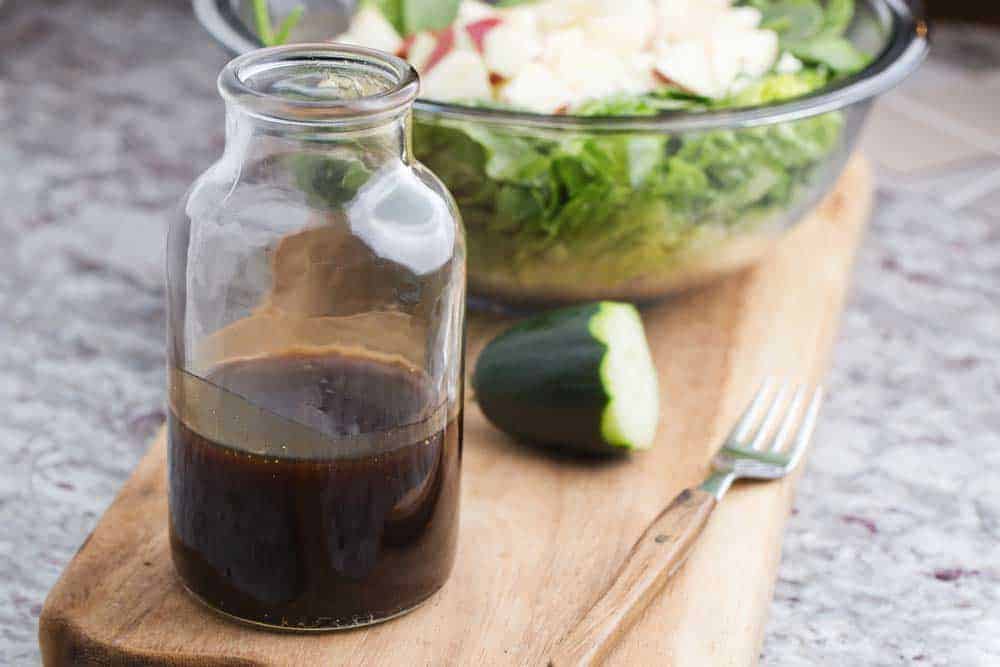Balsamic vinegar’s taste is probably its most distinct feature and what sets it apart from the readily available types of cooking vinegar out there. However, this unique taste is also the reason why most cooks panic when they’re running out of it. I’ve struggled to find a solution to this fiasco recently. Luckily, there's a variety of ingredients that can aid you as a substitute for balsamic vinegar.
This article concentrates on the substitutes for balsamic vinegar. Here, you’ll also be learning how to mix your own vinegar to get that unique taste of balsamic vinegar.
More...
Balsamic Vinegar Substitutes You Must Try
1. Sherry Vinegar

Let’s start with the first substitute that probably has the closest taste to that of balsamic vinegar. Sherry vinegar, akin to balsamic vinegar, has a sweet and mild taste. So, if you’re planning to use this vinegar, then there is no need for you to go through mixing and all that just to achieve the similar taste.
Meanwhile, sherry vinegar can also be used as is for dishes that need the balsamic vinegar as an ingredient. But if you’re like me who wants it to have this extra zing in it, I’d recommend the use of pomegranate molasses for some reduction.
Another thing that I have found about sherry vinegar is that it’s not only a good substitute for balsamic vinegar. This alternative is likewise known for aiding your body to increase its “good” cholesterol HDL while lowering your blood sugar level. Also, sherry vinegar is very much famed for its ability to help you shed some weight!
Watch this video to check on the other ways to use sherry vinegar in your kitchen.
2. Chinese Black Vinegar

Chinese vinegar’s composition of malt and glutinous rice makes it one of the better substitutions for balsamic vinegar. These ingredients contribute to its dark complex vinegar that is very much similar to balsamic vinegar. Similar to that of our first substitute, you no longer need to add the Chinese black vinegar to any ingredient as it has that very similar taste of this prized vinegar.
Chinese black vinegar also boasts of a long list of health benefits. These include cancer prevention, alleviation of cholesterol, energy production and helps with blood circulation.
But one factor that makes the Chinese vinegar superior to balsamic vinegar is inarguably the price it’s carrying. Today, balsamic vinegar can cost around $20 USD which is a little hefty if you ask me. The Chinese black vinegar won’t be breaking your wallet as it only costs half the price of balsamic.
3. Apple Cider Vinegar And Sugar

Your good old Apple Cider vinegar and sugar are a potent combination to substitute for your balsamic vinegar. Apple Cider is very much similar to balsamic vinegar’s fruitiness. And with just a little dash of sugar, you’re trouble of finding a replacement is over. Now, in order to achieve that distinctive taste of balsamic vinegar, you need a 1:2 ratio with these two ingredients.
To begin, just mix one tablespoon of Apple Cider vinegar with half a teaspoon of granulated sugar. You can also make use of other types of sugar such as white granulated sugar, brown sugar, and cane sugar.
Here's a step-by-step process for mixing the ingredients:
- Mix the Apple Cider vinegar and sugar thoroughly until the sugar is dissolved.
- Use half a teaspoon of honey if you're out of sugar.
- Taste the mixture. It should now taste like balsamic vinegar.
Now, I cannot stress enough the health benefits of taking apple cider vinegar. Apple cider vinegar consumption is widely regarded as one of the healthiest ways to detoxify. Some of its health benefits include the lowering of your blood sugar levels, the lessening of the symptoms of diabetes and my perennial favorite — its impact on your weight loss diet.
If you’re using apple cider vinegar, try to get the one that’s raw and organic. Stay away from those that are in a plastic container. Do you see any brown stuff at the bottom of the bottle? That’s called the “mother”. That’s the most nutritious part as it has all of the enzymes and live bacteria that make apple cider vinegar so powerful.
4. Red Wine Vinegar

If you don't mind a little bitter taste in your recipes and you’re looking for a balsamic vinegar substitute, then red wine vinegar might just work for you. As both kinds of vinegar are made of wine, red wine vinegar almost always ends up as an adequate replacement.
Red wine vinegar doesn’t contain cholesterol. Now I know why this vinegar is always present in my mother’s “special” kitchen cabinet. Apart from cholesterol, this vinegar also doesn’t come with fat and sodium. What else? You might be surprised to know that it also contains a voluminous amount of ant-aging antioxidants and anti-bacteriall properties that make it a suitable alternative for your skin care products!
Procedure:
- Combine and mix a tablespoon of red wine vinegar with half a teaspoon of sugar.
- Along with apple cider vinegar, you can also make use of your available sugar at home such as brown sugar, white granulated sugar, or even honey.
- Mix until you’re able to achieve that balsamic vinegar taste.
Did you know that red wine vinegar aids in weight loss too? The acetic acid in red wine vinegar suppresses accumulation of body fat. With regular and proper intake, you’ll have a significant drop in your Body Mass Index (BMI), weight, and you’ll lose some visceral fats in as short as 12 weeks. Surely, red wine vinegar is one of the healthier substitutes for balsamic vinegar.
5. Molasses, Lemon Juice And Soy Sauce

Who knew you can actually create your very own balsamic vinegar from scratch? By using a mixture of molasses, soy sauce, and lemon juice, you'll have your balsamic vinegar! With these three ingredients, you’ll be able to produce the balsamic vinegar’s sweet and salty acidic flavor.
Here’s what you should do:
Simply mix one part of molasses with a part of lemon juice along with a bit of soy sauce. I must recommend the adding of soy sauce one tablespoon at a time to prevent it from tasting too bitter. Also, you can use the same amount of honey or dark corn syrup.
In my practice, I always use the available sugar at home as opposed to these natural sweeteners. Now, if you follow suit, please take note that a cup of molasses equals to ¾ cup of firmly packed brown sugar. It also is equivalent to a normal white granulated sugar plus ¼ cup of water.
I would often purchase my molasses at my local store once my grandmother’s stash runs out. You can buy molasses online or at a grocery store near you.
6. Beef Stock and White Vinegar

Yes, seriously. A beef stock! You’re reading it right. Because balsamic vinegar is known for its strong taste, a beef stock can also replace that famed taste. Just add white vinegar and you’re good to go.
As soon as you have these ingredients, reduce your beef stock before adding a regular vinegar to it. Reduce the stock once again. Please note that you could use any type of vinegar that is available at your disposal.
Now while there are a variety of kinds of vinegar available out there, I’d still recommend the use of plain white vinegar because other types of vinegar produce a distinct flavor that might increase the taste of your beef stock.
After the beef stock reduction and vinegar mixture, you can play with the flavor by simply adding sugar into it. I often add coffee to it to provide some extra kick in it. While you’re mixing these, it’s crucial that you taste it from time to time to check if it’s getting closer to the balsamic vinegar taste.
7. Balsamic Vinaigrette

Balsamic vinaigrette’s inclusion in this list is a no-brainer. This proud Italian ingredient already has a massive amount of balsamic vinegar to begin with. Despite this, the usage of balsamic vinaigrette might not be that ideal for some as it contains other ingredients like oils, sugars, herbs, and salt. Nevertheless, if you’re just simply planning to add it to your salad dressing or as a spice, then this one might work for you.
Meanwhile, if you think your balsamic vinaigrette is lacking a little fruitiness or tanginess in it, simply add a hefty amount of a squeezed lemon juice to the mixture.
Watch this video to check on how to make your own balsamic vinaigrette.
Final Thoughts
Because balsamic vinegar is widely used as an ingredient for numerous dishes such as salads, sauces, meat dishes and on some desserts, it’s crucial to determine which of these you’re using the substitute for. All of these replacements vary in taste, and once you add them to other ingredients, the result may differ quite dramatically.
If you feel like I’ve missed a substitute on the list, please feel free to share them in the comment section below. And don't forget to share the article if you found it useful!

